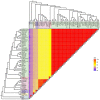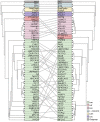Comparative genomics of the Liberibacter genus reveals widespread diversity in genomic content and positive selection history
- PMID: 37434713
- PMCID: PMC10330825
- DOI: 10.3389/fmicb.2023.1206094
Comparative genomics of the Liberibacter genus reveals widespread diversity in genomic content and positive selection history
Abstract
'Candidatus Liberibacter' is a group of bacterial species that are obligate intracellular plant pathogens and cause Huanglongbing disease of citrus trees and Zebra Chip in potatoes. Here, we examined the extent of intra- and interspecific genetic diversity across the genus using comparative genomics. Our approach examined a wide set of Liberibacter genome sequences including five pathogenic species and one species not known to cause disease. By performing comparative genomics analyses, we sought to understand the evolutionary history of this genus and to identify genes or genome regions that may affect pathogenicity. With a set of 52 genomes, we performed comparative genomics, measured genome rearrangement, and completed statistical tests of positive selection. We explored markers of genetic diversity across the genus, such as average nucleotide identity across the whole genome. These analyses revealed the highest intraspecific diversity amongst the 'Ca. Liberibacter solanacearum' species, which also has the largest plant host range. We identified sets of core and accessory genes across the genus and within each species and measured the ratio of nonsynonymous to synonymous mutations (dN/dS) across genes. We identified ten genes with evidence of a history of positive selection in the Liberibacter genus, including genes in the Tad complex, which have been previously implicated as being highly divergent in the 'Ca. L. capsica' species based on high values of dN.
Keywords: bacteria; evolution; pan-genome; plant pathogen; positive selection.
Copyright © 2023 Batarseh, Batarseh, Morales-Cruz and Gaut.
Conflict of interest statement
The authors declare that the research was conducted in the absence of any commercial or financial relationships that could be construed as a potential conflict of interest.
Figures








Similar articles
-
Divergent Host-Microbe Interaction and Pathogenesis Proteins Detected in Recently Identified Liberibacter Species.Microbiol Spectr. 2022 Aug 31;10(4):e0209122. doi: 10.1128/spectrum.02091-22. Epub 2022 Jul 28. Microbiol Spectr. 2022. PMID: 35900091 Free PMC article.
-
A new and accurate qPCR protocol to detect plant pathogenic bacteria of the genus 'Candidatus Liberibacter' in plants and insects.Sci Rep. 2023 Feb 27;13(1):3338. doi: 10.1038/s41598-023-30345-0. Sci Rep. 2023. PMID: 36849507 Free PMC article.
-
Comparative Phylogenomic Analysis Reveals Evolutionary Genomic Changes and Novel Toxin Families in Endophytic Liberibacter Pathogens.Microbiol Spectr. 2021 Oct 31;9(2):e0050921. doi: 10.1128/Spectrum.00509-21. Epub 2021 Sep 15. Microbiol Spectr. 2021. PMID: 34523996 Free PMC article.
-
Interactions of Liberibacter Species with Their Psyllid Vectors: Molecular, Biological and Behavioural Mechanisms.Int J Mol Sci. 2022 Apr 5;23(7):4029. doi: 10.3390/ijms23074029. Int J Mol Sci. 2022. PMID: 35409386 Free PMC article. Review.
-
Citrus huanglongbing: a newly relevant disease presents unprecedented challenges.Phytopathology. 2013 Jul;103(7):652-65. doi: 10.1094/PHYTO-12-12-0331-RVW. Phytopathology. 2013. PMID: 23441969 Review.
Cited by
-
Exploring the Genetic Networks of HLB Tolerance in Citrus: Insights Across Species and Tissues.Plants (Basel). 2025 Jun 11;14(12):1792. doi: 10.3390/plants14121792. Plants (Basel). 2025. PMID: 40573779 Free PMC article.
-
Bacterial community structure of Physalis peruviana L. fruit exocarp and the presence of pathogens with possible implications on food safety.Front Plant Sci. 2024 Jul 18;15:1410314. doi: 10.3389/fpls.2024.1410314. eCollection 2024. Front Plant Sci. 2024. PMID: 39091311 Free PMC article.
-
Whole genome sequences of 135 "Candidatus Liberibacter asiaticus" strains from China.Sci Data. 2024 Sep 19;11(1):1018. doi: 10.1038/s41597-024-03855-3. Sci Data. 2024. PMID: 39300139 Free PMC article.
References
-
- Albrecht U., Bowman K. D. (2009). Candidatus Liberibacter asiaticus and Huanglongbing effects on Citrus seeds and seedlings. HortScience 44, 1967–1973. doi: 10.21273/HORTSCI.44.7.1967 - DOI
LinkOut - more resources
Full Text Sources

